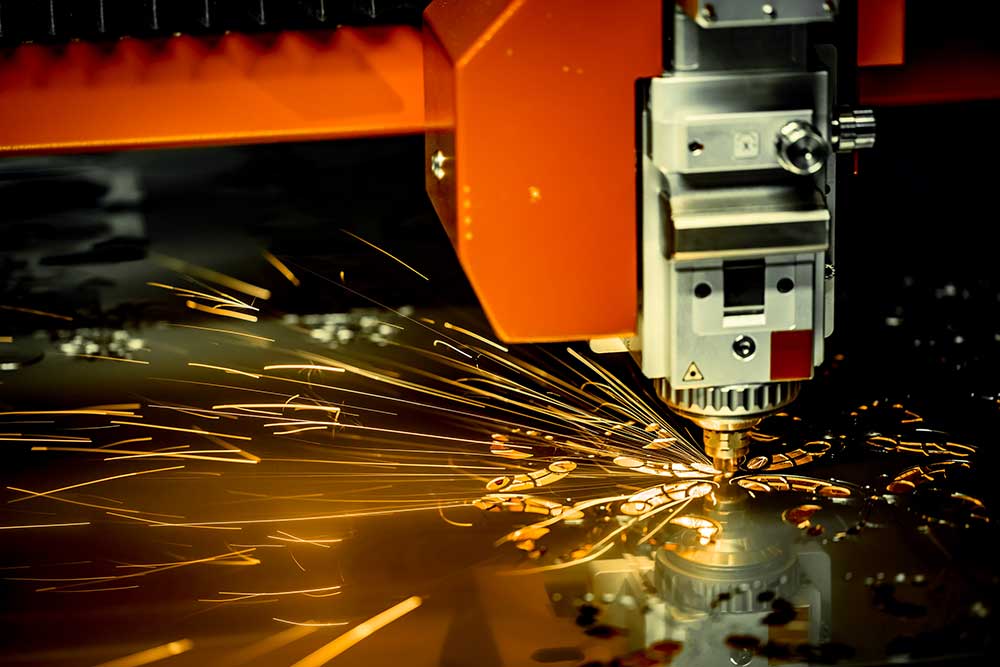Are you getting ready to start that engraving business you have been dreaming about for so long? Or is your welding business expanding and in urgent need of more machines to carry the increased workload? For any trade that involves any kind of cutting, engraving, or etching, the owner will face the decision of which kind of laser to purchase for his work. This brings up the question, if a fiber laser outperforms a CO2 laser, and consequently, it is a question we are asked frequently. As so often, it depends on the intended usage of the laser. There is a vast array of laser machines, and just what exactly your main application is will influence your decision. So, in order to help you with this decision-making process, let’s explore the different applications, as well as the pros and cons of fiber lasers versus CO2 lasers.
CO2 Lasers
CO2 lasers have been around much longer than fiber lasers, and have been used, among other things, for cutting and welding metal plates. They are also dominating the pharmaceutical industry, as well as the food and packaged goods industry. This is due to a couple of reasons. For one, they are easy to control and operate. They are also very versatile, and even superior when it comes to any jobs involving the breaking of carbon-oxygen bonds, which are present in paper, cardboard, wood, but also plastics, acrylics, glass, ceramics, and even stone. However, as explained in more detail further on, to accomplish all these things, a CO2 laser uses much more power than a fiber laser.
How CO2 Lasers Work
CO2 lasers mainly consist of an oscillator and a chiller unit. A 4kW CO2 laser and chiller consume approximately 70 kW power when at maximum power. CO2 lasers operate at a wavelength of 10,600 nm. The wavelength determines which type of material the laser can handle or can handle best. CO2 lasers are excellent tools for cutting thick materials, due to their quick initial piercing time, and quick straight-line cutting for materials over 5mm. In addition, they usually leave smoother surfaces than a fiber laser at the cut edges.
CO2 lasers are part of the gas laser group, and they operate on an electric discharge. A CO2 laser has a discharge tube filled with not only CO2 gas, but equal amounts of carbon dioxide and nitrogen gas, as well as minor amounts of xenon, helium, and hydrogen. Altering the proportions of the gases allows for accommodating for specific work applications. An electric current is then released into the gas discharge tube. To increase the strength of the generated beam it is reflected internally by a series of mirrors surrounding the discharge tube. These mirrors are usually silver, but can also be gold, which is generally used in high-power applications.
Price Tag CO2 Laser vs. Fiber Laser
The initial cost for a CO2 laser is lower than for a fiber laser machine. CO2 laser machines can be purchased for anywhere between $35,000 and $80,000, while a fiber laser will cost you anywhere between $40,000 and even up to $1,000,000. However, as we will see in the next section, the difference in operating costs might balance out the initial high cost of a fiber laser.
Fiber Lasers
Since 2014, fiber laser cutters have overtaken the bulk of the market from the traditionally used CO2 lasers. In contrast to CO2 lasers, fiber lasers operate at a wavelength of 1,060 nm. For fine cutting, the fiber lasers take the prize, since they can be ultra-focused and apply a lot of power in one tiny spot. As the high energy of the fiber laser is focusing on the material, the beam melts and vaporizes the surface and leaves a permanent mark. The permanent mark is thus brought about by a mix of mechanical force and chemical reactions.
Fiber lasers come with a long list of advantages. For one, they are smaller in size than CO2 lasers, which makes them great machines for the small business owner who may be running an engraving business out of their garage or out of their small storefront. Secondly, they are low-maintenance machines with a long service life coming with more than 100,000 operating hours. Thirdly, fiber lasers are able to provide a high energy output. They can have power outputs of up to 6 kW, and an ultra-focused fiber laser beam can be 100 times more powerful than a CO2 laser beam. At the same time, fiber lasers have a high power conversion rate. This effectively means that, although a fiber laser can apply higher energy in a focused spot, it will also use up less energy from your power supply. A 4kW fiber laser and chiller consumes about only 18 kW power when at maximum power—compared to the 70kW consumed by a 4kW CO2 laser. Fiber lasers are able to use between 70-80% of their power input resulting in less heat drained into their surroundings, which in turn will require less air conditioning to cool back down the workspace. So, since they are operating more efficiently and using less power than CO2 lasers, they provide two ways of energy bill savings for the business owner. Lastly, they themselves are not prone to overheating, meaning there is less heat management required by the laser operator. For these reasons, fiber lasers are the preferable laser for jobs such as welding, metal cutting, and engraving.
Conclusion
Whether you decide to use a CO2 or Fiber Laser, you will still need to consider a laser fume extractor. Both types of lasers will generate respirable dust and VOCs and therefore will require a high-quality fume extractor specifically designed for laser fumes As we can see, there are many variables coming into play when choosing your laser. In order to make sure you take every detail into account it is best to call a laser cutter retailer with excellent customer service. They will be able to consult you in regards to not only if a fiber or a CO2 laser is the best fit for your company, but also which specific fiber or CO2 laser is best suited. No matter which type of laser you decide on, we are here to assist you in picking the correct fume extractor machine for your laser. Give our friendly customer service a call at +1 514-840-9696 EXT. 102
when you are ready!




Recent Comments